内分泌英文病历讨论(学生版)
- 格式:docx
- 大小:81.36 KB
- 文档页数:8
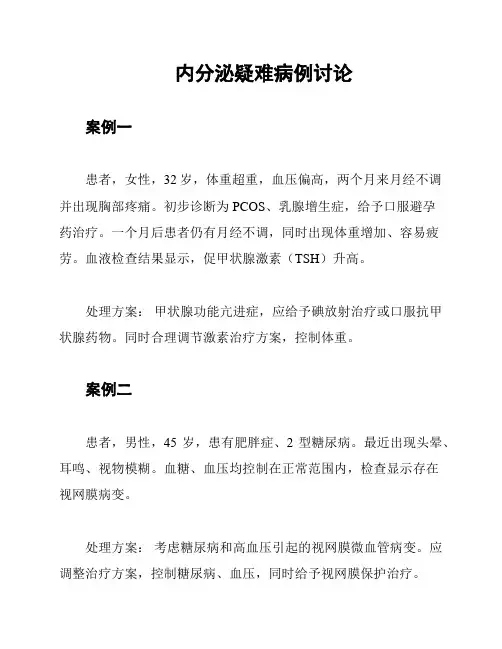
内分泌疑难病例讨论
案例一
患者,女性,32岁,体重超重,血压偏高,两个月来月经不调并出现胸部疼痛。
初步诊断为PCOS、乳腺增生症,给予口服避孕
药治疗。
一个月后患者仍有月经不调,同时出现体重增加、容易疲劳。
血液检查结果显示,促甲状腺激素(TSH)升高。
处理方案:甲状腺功能亢进症,应给予碘放射治疗或口服抗甲状腺药物。
同时合理调节激素治疗方案,控制体重。
案例二
患者,男性,45岁,患有肥胖症、2型糖尿病。
最近出现头晕、耳鸣、视物模糊。
血糖、血压均控制在正常范围内,检查显示存在
视网膜病变。
处理方案:考虑糖尿病和高血压引起的视网膜微血管病变。
应调整治疗方案,控制糖尿病、血压,同时给予视网膜保护治疗。
案例三
患者,女性,28岁,有甲状腺肿大、乳腺纤维瘤、骨质疏松等病症。
近期出现心悸、乏力、肢体无力等症状,血液检查显示钙离子异常。
处理方案:甲状旁腺功能亢进,应考虑手术治疗、药物治疗、补钙等综合治疗方案。
同时控制激素治疗,开展恰当的康复治疗。
结论
内分泌疑难病例需要全面综合考虑病情,合理制定治疗方案,同时也需要注意病人的心理疏导和健康教育。
在治疗过程中,可以尝试多个方案,以取得更好的效果。

临床病例讨论英语作文Clinical Case Discussion。
Introduction:Clinical case discussions play a crucial role in medical education as they provide an opportunity for healthcare professionals to analyze and learn from real-life patient scenarios. In this essay, we will delve into a clinical case involving a middle-aged man who presented with a complex set of symptoms. By discussing the patient's history, physical examination, and diagnostic tests, we aim to highlight the importance of a comprehensive approach to diagnosis and treatment.Case Presentation:Mr. Smith, a 45-year-old male, visited the hospital complaining of severe fatigue, joint pain, and a persistent low-grade fever. Upon reviewing his medical history, it wasrevealed that he had been experiencing these symptoms for the past six months. Mr. Smith mentioned that he had previously been diagnosed with rheumatoid arthritis, for which he had been taking medication regularly. However, his current symptoms were different from his previous experiences with arthritis.Physical Examination:During the physical examination, Mr. Smith appeared pale and fatigued. His joints were swollen, warm to touch, and tender. There was also evidence of synovitis inmultiple joints. Additionally, the patient had enlarged lymph nodes in his neck and groin. The rest of the physical examination, including cardiovascular and respiratory systems, was unremarkable.Diagnostic Tests:To further investigate the underlying cause of Mr. Smith's symptoms, several diagnostic tests were performed. Blood tests revealed an elevated erythrocyte sedimentationrate (ESR) and C-reactive protein (CRP) levels, indicating inflammation in the body. Rheumatoid factor and anti-cyclic citrullinated peptide (anti-CCP) antibodies were also detected, confirming the presence of rheumatoid arthritis.However, given the atypical nature of the joint pain and the presence of lymphadenopathy, a biopsy of an enlarged lymph node was performed. The histopathological examination revealed the presence of non-caseating granulomas, leading to a diagnosis of sarcoidosis. This condition explained the joint symptoms, fatigue, and fever experienced by the patient.Discussion:The case of Mr. Smith highlights the importance of considering alternative diagnoses when a patient's symptoms do not align with their previous medical history. In this instance, the initial assumption of a rheumatoid arthritis flare-up was challenged by the presence of lymphadenopathy and atypical joint symptoms. The diagnosis of sarcoidosis was made based on the biopsy results, leading toappropriate management and treatment.Sarcoidosis is a multisystem inflammatory disorder characterized by the formation of granulomas in various organs, most commonly the lungs and lymph nodes. However,it can affect any organ system, leading to a wide range of symptoms. In this case, the patient's joint involvement and constitutional symptoms were attributed to sarcoidosis.Conclusion:Clinical case discussions are invaluable in medical education as they provide an opportunity to analyze real-life scenarios and enhance diagnostic and management skills. The case of Mr. Smith emphasizes the importance of a comprehensive approach to diagnosis, consideringalternative diagnoses when necessary. By sharing and discussing clinical cases, healthcare professionals can continue to learn and improve patient care.。
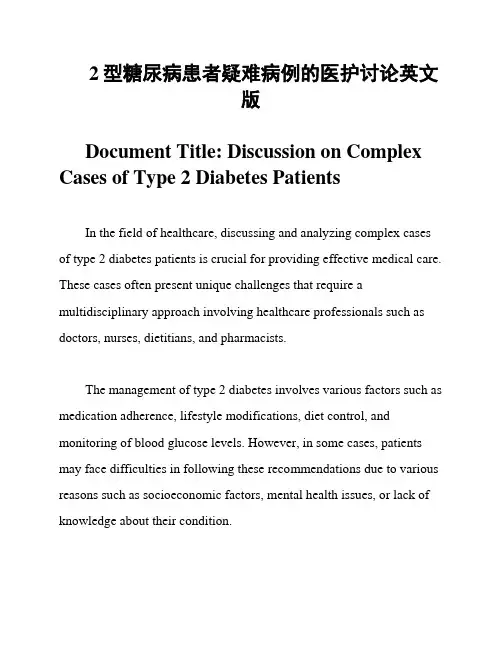
2型糖尿病患者疑难病例的医护讨论英文版
Document Title: Discussion on Complex Cases of Type 2 Diabetes Patients
In the field of healthcare, discussing and analyzing complex cases of type 2 diabetes patients is crucial for providing effective medical care. These cases often present unique challenges that require a multidisciplinary approach involving healthcare professionals such as doctors, nurses, dietitians, and pharmacists.
The management of type 2 diabetes involves various factors such as medication adherence, lifestyle modifications, diet control, and monitoring of blood glucose levels. However, in some cases, patients may face difficulties in following these recommendations due to various reasons such as socioeconomic factors, mental health issues, or lack of knowledge about their condition. In our discussion, we will focus on a few challenging cases of type 2 diabetes patients and explore potential strategies for addressing their unique needs. By sharing our experiences and expertise, we aim to enhance our understanding of the complexities involved in managing diabetes and improve patient outcomes.
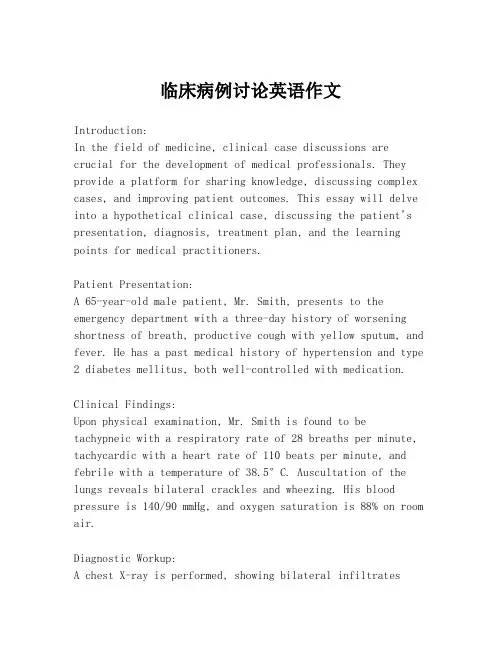
临床病例讨论英语作文Introduction:In the field of medicine, clinical case discussions are crucial for the development of medical professionals. They provide a platform for sharing knowledge, discussing complex cases, and improving patient outcomes. This essay will delve into a hypothetical clinical case, discussing the patient's presentation, diagnosis, treatment plan, and the learning points for medical practitioners.Patient Presentation:A 65-year-old male patient, Mr. Smith, presents to the emergency department with a three-day history of worsening shortness of breath, productive cough with yellow sputum, and fever. He has a past medical history of hypertension and type 2 diabetes mellitus, both well-controlled with medication.Clinical Findings:Upon physical examination, Mr. Smith is found to be tachypneic with a respiratory rate of 28 breaths per minute, tachycardic with a heart rate of 110 beats per minute, and febrile with a temperature of 38.5°C. Auscultation of the lungs reveals bilateral crackles and wheezing. His blood pressure is 140/90 mmHg, and oxygen saturation is 88% on room air.Diagnostic Workup:A chest X-ray is performed, showing bilateral infiltratesconsistent with pneumonia. Blood cultures are taken, and sputum is sent for Gram stain and culture. Mr. Smith is also tested for influenza and COVID-19, both of which are negative. His white blood cell count is elevated at 15,000/mm3, and C-reactive protein (CRP) is 150 mg/L.Differential Diagnosis:The primary differential diagnoses include bacterial pneumonia, aspiration pneumonia, and atypical pneumonia.Given the patient's symptoms and imaging findings, bacterial pneumonia is the most likely diagnosis.Treatment Plan:Mr. Smith is started on empiric antibiotic therapy with ceftriaxone and azithromycin, covering both typical and atypical pathogens. He is also placed on supplemental oxygento maintain oxygen saturation above 90%. Fluid management and close monitoring of electrolytes are essential due to his comorbidities.Outcome and Follow-up:After 48 hours of treatment, Mr. Smith's symptoms begin to improve, and his oxygen saturation stabilizes. The sputum culture identifies Streptococcus pneumoniae, and antibiotic sensitivity testing confirms the effectiveness of the current antibiotics. Mr. Smith is discharged after a week of hospitalization with a prescription for a 10-day course of antibiotics and a follow-up appointment in two weeks.Learning Points:This case highlights the importance of a thorough clinicalexamination and prompt diagnostic workup in the management of pneumonia. It also underscores the need for close monitoring of patients with comorbidities to prevent complications. Lastly, it serves as a reminder of the importance of antimicrobial stewardship, ensuring that antibiotics are used appropriately to prevent resistance.Conclusion:Clinical case discussions are an invaluable educational tool for healthcare professionals. They enhance our understanding of complex clinical scenarios, improve diagnostic and treatment skills, and contribute to the advancement of medical practice for the benefit of patients.。
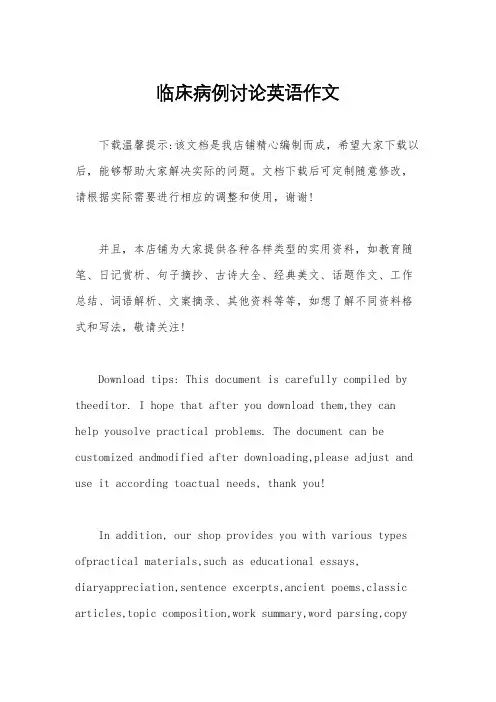
临床病例讨论英语作文下载温馨提示:该文档是我店铺精心编制而成,希望大家下载以后,能够帮助大家解决实际的问题。
文档下载后可定制随意修改,请根据实际需要进行相应的调整和使用,谢谢!并且,本店铺为大家提供各种各样类型的实用资料,如教育随笔、日记赏析、句子摘抄、古诗大全、经典美文、话题作文、工作总结、词语解析、文案摘录、其他资料等等,如想了解不同资料格式和写法,敬请关注!Download tips: This document is carefully compiled by theeditor. I hope that after you download them,they can help yousolve practical problems. The document can be customized andmodified after downloading,please adjust and use it according toactual needs, thank you!In addition, our shop provides you with various types ofpractical materials,such as educational essays, diaryappreciation,sentence excerpts,ancient poems,classic articles,topic composition,work summary,word parsing,copyexcerpts,other materials and so on,want to know different data formats andwriting methods,please pay attention!ChatGPT:1. Medical Case Study: A Glimpse into Real-Life Diagnosis。


临床病例讨论英语作文Clinical Case Discussion。
Introduction。
Clinical case discussion is an essential aspect of medical education and practice. It involves the examination of a patient's medical history, physical examination, and laboratory results to arrive at a diagnosis and treatment plan. In this essay, we will discuss a clinical case of a patient with hypertension and how the condition was managed.Case Presentation。
Mrs. X, a 50-year-old female, presented to the clinic with complaints of headaches and dizziness for the past two weeks. She also reported feeling fatigued and haddifficulty sleeping. Further questioning revealed that she had a family history of hypertension and had been experiencing occasional chest pains. Her medical historywas significant for obesity, type 2 diabetes, and dyslipidemia. On examination, her blood pressure was160/100 mmHg, and her body mass index (BMI) was 32 kg/m2.Diagnosis。
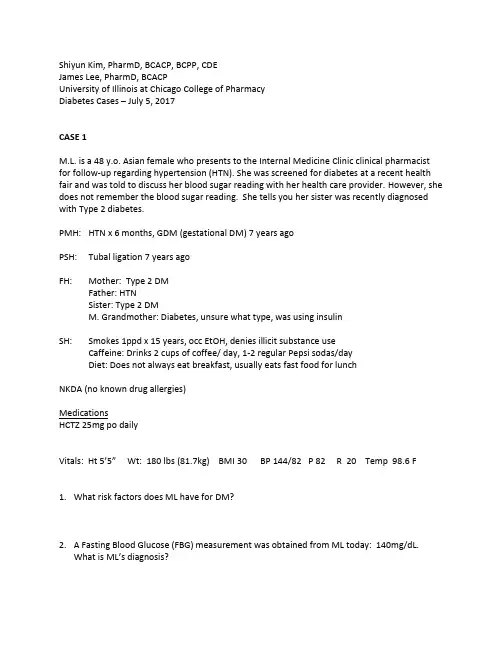
Shiyun Kim, PharmD, BCACP, BCPP, CDEJames Lee, PharmD, BCACPUniversity of Illinois at Chicago College of PharmacyDiabetes Cases – July 5, 2017CASE 1M.L. is a 48 y.o. Asian female who presents to the Internal Medicine Clinic clinical pharmacist for follow-up regarding hypertension (HTN). She was screened for diabetes at a recent health fair and was told to discuss her blood sugar reading with her health care provider. However, she does not remember the blood sugar reading. She tells you her sister was recently diagnosed with Type 2 diabetes.PMH: HTN x 6 months, GDM (gestational DM) 7 years agoPSH: Tubal ligation 7 years agoFH: Mother: Type 2 DMFather: HTNSister: Type 2 DMM. Grandmother: Diabetes, unsure what type, was using insulinSH: Smokes 1ppd x 15 years, occ EtOH, denies illicit substance useCaffeine: Drinks 2 cups of coffee/ day, 1-2 regular Pepsi sodas/dayDiet: Does not always eat breakfast, usually eats fast food for lunchNKDA (no known drug allergies)MedicationsHCTZ 25mg po dailyVitals: Ht 5’5” Wt: 180 lbs (81.7kg) BMI 30 BP 144/82 P 82 R 20 Temp 98.6 F1.What risk factors does ML have for DM?2. A Fasting Blood Glucose (FBG) measurement was obtained from ML today: 140mg/dL.What is ML’s diagnosis?3.What specific lifestyle modification interventions would you suggest?4.Which labs should you order?5.What medication therapy for her blood glucose would you initiate? (state dose andregimen)6.How would you optimize her current anti-hypertensive regimen? (statemedication class and monitoring parameters)7.What specific education should you provide for ML today?8.When would you follow-up with ML?CASE 2ML returns for follow-up appointment. She is unsure if she is eating the best foods to control her BG. She is tolerating her new medications well. She is trying to eat breakfast, but has been mostly been eating a donut or potato chips on her way to work. She is increasing her physical activity to 10 minutes three days a week by walking after work. She has been eating 1 banana and chips for snacks.She brought in her BG readings.SMBG:Fasting BG 160-180mg/dlAfter meals 200-240mg/dl1.What aspects of ML management of diabetes could be improved?2.How would you adjust ML’s current medication therapy? (Give dose and regimen)3.What are the clinical benefits of your recommendations?4.When would you like to follow up with ML?。
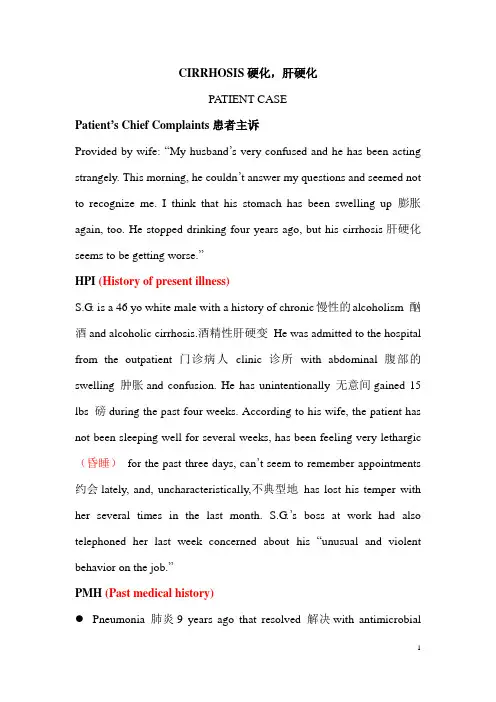
CIRRHOSIS硬化,肝硬化PATIENT CASEPatient’s Chief Complaints患者主诉Provided by wife: “My husband’s very confused and he has been acting strangely. This morning, he couldn’t answer my questions and seemed not to recognize me. I think that his stomach has been swelling up 膨胀again, too. He stopped drinking four years ago, but his cirrhosis肝硬化seems to be getting worse.”HPI (History of present illness)S.G. is a 46 yo white male with a history of chronic慢性的alcoholism 酗酒and alcoholic cirrhosis.酒精性肝硬变He was admitted to the hospital from the outpatient门诊病人clinic诊所with abdominal 腹部的swelling 肿胀and confusion. He has unintentionally 无意间gained 15 lbs 磅during the past four weeks. According to his wife, the patient has not been sleeping well for several weeks, has been feeling very lethargic (昏睡)for the past three days, can’t seem to remember appointments 约会lately, and, uncharacteristically,不典型地has lost his temper with her several times in the last month. S.G.’s boss at work had also telephoned her last week concerned about his “unusual and violent behavior on the job.”PMH (Past medical history)Pneumonia 肺炎9 years ago that resolved 解决with antimicrobial抗菌的therapy 治疗●Cirrhosis 肝硬化secondary to继发heavy alcohol use大量饮酒diagnosed诊断4 years ago with ultrasound超声波and liver biopsy 活组织检查( micronodular小结的cirrhosis)●H/O uncontrolled ascites腹水and peripheral外围的edema浮肿,水肿(H/O: history of)●H/O two upper 上部的,较高的GI升糖指数hemorrhages出血上消化道出血?from esophageal食管的varices 静脉曲张●H/O anemia贫血●H/O E. coli-induced大肠杆菌引起的bacterial peritonitis 细菌性腹膜炎4 years ago●H/O acute急性的pancreatitis胰腺炎secondary to alcohol abuse饮酒过度●No history to suggest cardiac心脏的or gallbladder 胆囊disease翻译:没有心脏或者胆囊的疾病史●No previous diagnosis诊断of viral病毒的or autoimmune 自身免疫的hepatitis肝炎翻译:先前没有病毒性或者自身免疫性肝炎的诊断SURG外科●S/P appendectomy阑尾切除术requiring blood transfusions 输血30years ago●S/P open-reduction开放复位internal内部的fixation定影of rightfemur大腿骨secondary to继发MV A摩托车车祸5 years ago (SP: status post病后状态; MV A: motor vehicle accident)FH (Family history)●Father died at age 52 from liver disease of unknown etiology病因翻译:父亲由于不明原因的肝脏疾病在52岁时去世●Mother had rheumatoid arthritis风湿性关节炎and ulcerative colitis溃疡性结肠炎, died from massive stroke 严重中风at age 66●Maternal aunt姨母, age 71, with Graves disease Graves 病●Patient has no siblings兄弟姐妹翻译:病人没有兄弟姐妹SH (Social history)●Educated through eighth grade翻译:8年级毕业●Department store men’s clothing manager and salesman, 17-yearcareer●Married for 19 years with 1 daughter, age 10翻译:结婚19年了,有一个10岁的女儿●H/O ethanol乙醇abuse, quit 5 years ago following MV A, previouslydrank 3 cases箱of beer/wee k×15 years●H/O IVDA (heroin) and intranasal鼻内的cocaine可卡因, quit5years ago (IVDA:intravenous静脉的drug abuse)●Has smoked approximately 1/2 ppd for many years (ppd: packs包per day)Meds (medications医疗护理)●Propranolol心得安(用于治疗心律不齐,心绞痛等)10 mg po TID(po: by mouth口服, TID: three times daily)●Spironolactone螺内酯(一种利尿药)50 mg po QD (QD: every day) ●Furosemide 速尿灵20 mg po QD●MVI 多种维生素滴注1 tablet药片po QD每天●Occasional偶尔的ibuprofen布洛芬(抗炎,阵痛药)oracetaminophen(退热药)for headache●Patient has H/O non-compliance 违反义务with his medications ALL(Allergy过敏症)NKDA (no known drug allergies)ROS (review of systems)●Increasing abdominal girth 胸围(周长)●(-) complaints of abdominal pain, fever, chills,寒冷nausea,呕吐vomiting,呕吐hematemesis咯血, tarry stools柏油样便, loss of appetite,食欲减退cough,咳嗽chest pain胸痛, SOB (shortness of breath), 呼吸急速lightheadedness,头昏眼花的weakness, blood in the urine(尿), 尿中带血diarrhea,痢疾constipation,便秘and dry mouth口干Patient Case Question 1. Hematolysis 咯血and tarry stools拉黑便are clinical 临床的signs of which serious potential complication 并发症ofcirrhosis?Gen (general)The patient is restless, mildly 适度地jaundiced,患黄疸病的and disoriented紊乱的to time, place, and people. He is slow to answer questions and his answers make little sense. He is ill-appearing but in no obvious distress痛苦.VS (Vital重要的signs)●BP 120/75, P 83 and regular ( supine仰卧的)●BP118/70, P 80 and regular( standing站立的)●RR 14 and unlabored平静的●T 98.8 F orally口温37.1摄氏度●WT 171 1bs 体重77.6千克●HT 5 ft-7 in●SaO2 =97﹪Skin●Warm, dry, and well perfused 遍布with normal turgor肿胀●Mild jaundice轻微黄疸●( +) spider nevi on chest胸部有蜘蛛痣●(-)palmar erythema肝掌●Several ecchymoses(瘀斑)on lower extremities肢端●Large “cobra” tattoo 眼镜蛇纹身on right upper arm右上臂HEENT (head, eyes, ears, nose, throat)●(-)bruises淤青, masses,集中and deformities畸形on head●( +) icteric sclera巩膜黄染●Pupils 瞳孔at 3 mm and reactive to light光反应灵敏●EOMI (extra-ocular眼睛的movement intact完好无缺的)●Funduscopic exam 眼底镜检查WNL (WNL: within normallimits)●TMs clear and intact未损伤的(tympanic membrane鼓膜)鼓膜完好无损,听力清晰●O/P pink, clear, and moist潮湿的without erythema红斑orlesions伤口Neck/LN (lymph nodes淋巴结)●Supple柔软的●(-) JVD (jugular venous颈静脉detension轻松)●(-) goiter, thyroid nodules, carotid bruits, and adenopathy Chest●Lungs CTA bilaterally without wheezes or crackles (CTA: clear toauscultation听诊)●Diaphragmatic excursions WNL●Good air exchange●( +) gynecomastiaHeart●RRR (regular rate and rhythm)●Normal S1 and S2 with no S3 or S4●No m/r/g heard (m/r/g: murmur/rub/gallop)Abd (abdomen腹部)●Moderately distended, firm, and slightly tender●( +) prominent veins observed around umbilicus●( +) HSM (hepatosplenomegaly)●Active BS (bowel sounds)●(-) guarding, rebound tenderness, palpable masses, and aortic,iliac, and renal bruitsGenit/Rect (genitalia/rectum)●Heme-negative stool●Penis normal, testicles moderately atrophic but without masses●Normal sphincter tone●( +) hemorrhoids●Prostate may be slightly enlarged but (-)for nodules andtendernessMS/Ext (mental status/extremities)●No clubbing or edema●Good peripheral pulses at 2+ throughout●Normal range of motion throughoutNeuro●CNs grossly intact●Brisk DTRs at 2+ (DTR: deep tendon response)●Slight asterixis noted●Strength is equal bilaterally●Confused and disoriented●Negative Babinski●Sensory grossly intactPatient Case Question 2. Identify a minimum of 15 clinical signs and symptoms that are consistent with a diagnosis of cirrhosis. Laboratory Blood Test ResultsSee Patient Case Table 18.1AFP: α-fetoprotein (normal 0-15 ng/mL), ANA: antinuclear antibody, MCV: mean corpuscular volume, NH3 (normal 18-60 μg/mL)Patient Case Question 3. Is the patient anemic 贫血at this time and, if so, is the anemia normocytic正常红细胞性贫血microcytic小红细胞性贫血or macrocytic巨细胞性贫血?Patient Case Question 4. What is the most significant abnormality变态that this patient’s CBC (completed blood count总红细胞数) has revealed 显示?Patient Case Question 5.Based on the laboratory data, why has this patient’s cirrhosis肝硬化shown a sudden and unexpected progression上升?Patient Case Question 6. Identify鉴定four risk factors that may have contributed to导致this patient’s current condition.Patient Case Question 7.Why can bacterial peritonitis 细菌性腹膜炎be ruled out as a current potential diagnosis潜在的诊断?Patient Case Question 8.What justification理由might the patient’s primary health care provider have for conducting an ANA test?Patient Case Question 9.Why can hemochromatosis血色沉着病be ruled out as a contributing factor to this patient’s condition?Patient Case Question 10. Why can Wilson disease be ruled out as a contributing factor to this patient’s condition?Patient Case Question 11. Why can autoimmune hepatitis自身免疫性肝炎and primary biliary cirrhosis原发性胆汁性肝硬化be ruled out as contributing factors to this patient’s condition?Patient Case Question 12.Is there any evidence that this patient is at high risk for osteoporosis骨质疏松症?Patient Case Question 13.Identify two abnormal laboratory tests thatare consistent with符合ascites腹水.Patient Case Question 14. Which single laboratory test strongly suggests that the patient has developed hepatic encephalopathy肝性脑病? Patient Case Question 15.How would you grade this patient’s encephalopathy脑病?Patient Case Question 16. What is this patient’s CTP score?Patient Case Question 17. What is the probability that this patient will live for one year?Patient Case Question 18.Does this patient have any signs of dehydration 脱水or hepatorenal syndrome肝肾综合征?Patient Case Question 19.The patient’s primary care provider has decided to conduct extensive大量的clinical 门诊的studies for the diagnosis 诊断of liver cancer. Which single abnormal laboratory value 评价has raised a concern that hepatocellular carcinoma肝细胞癌may have developed?问题19:这个病人的初级保健提供者已经打算为肝癌的诊断进行广泛的临床研究。
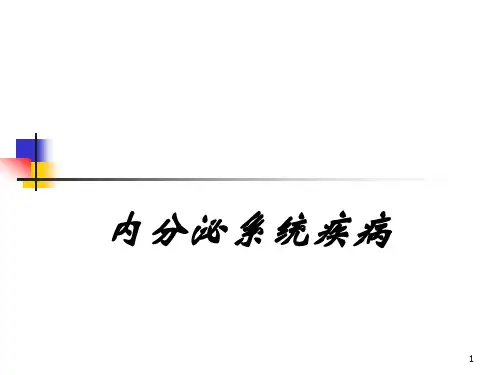

【主诉】停经59天,阴道少量出血3天【现病史】既往月经规律,初潮12岁,月经周期35天,经期4天,经量中等,色暗红,经期无腹痛,无血块,末次月经2016年10月16日。
10天前自测尿妊娠阳性,3天前阴道少量出血,就诊长安医院B超:剖宫产瘢痕处无回声,请结合临床。
为进一步治疗,门诊以“子宫疤痕妊娠”收住院。
发病以来,精神、食纳可,二便正常,无明显消瘦。
【既往史】既往身体健康,否认外伤,2013年7月行剖腹产手术;否认输血史;否认药物及食物过敏史;否认结核、肝炎等急慢性传染病史;否认糖尿病、肾病史、高血压病史;预防接种史不详。
【个人史】生于原籍,久居本地,未到过牧区及疫区,无特殊及不良嗜好。
【月经婚育史】既往月经规律,初潮12岁,月经周期35天,经期4天,经量中等,色暗红,经期无腹痛,无血块,末次月经2016年10月16日。
27岁结婚,丈夫原配,体健。
孕5产1,1-0-3-1。
2013年7月行剖腹产手术。
【家族史】父母及兄弟姐妹体健,否认高血压,心脏病,糖尿病、肾病等家族遗传病;否认传染病史。
体格检查体温:36.4℃,脉搏:75次/分,呼吸:19次/分,血压:112/76mmHg,体重:56kg。
妇科检查:外阴:已婚未产式,阴毛女性分布;阴道:通畅,皱襞存在,粘膜不红,分泌物色,粘稠,量多少中;宫颈:光滑糜烂Ⅰ°/ Ⅱ°/ Ⅲ;子宫:前/中/后位形态,常大,质地,活动,无压痛;附件:双侧附件区未扪及明显异常。
三合诊:。
肛诊:。
辅助检查2016-12-14长安医院B超:宫腔下段剖宫产瘢痕处可见大小约2.1*1.5cm的无回声,其内未见卵黄囊,未见胚芽组织及原始心管搏动,双附件未见明显异常。
子宫直肠窝未见液性暗区。
【初步诊断】(按ICD-10规定标准列出)子宫瘢痕妊娠治疗经过:2016-12-15 入院,完善各项检查2016-12-16 行双侧子宫动脉灌注/栓塞术2016-12-17 继续给予补液对症治疗2016-12-18 行清宫术护理诊断知识缺乏:与病人对疾病相关知识的了解不足有关焦虑与恐惧:与病人对手术结果担心治疗效果预后有关疼痛:与手术切口有关有皮肤完整性受损的危险:与术后取被迫体位、手术切口疼痛活动减少有关护理措施1、向病人家属宣教疾病相关知识2、告知病人手术必要性及手术相关知识3、观察尿管是否在位,尿液色、质、量4、观察病情变化及生命体征5、加强与病人的交流与沟通,观察患者的阴道出血和腹痛情况6、定时翻身,鼓励和协助病人经常更换卧位,每两小时翻身一次7、保护患者皮肤,保持患者和床单位的清洁和干燥8、促进患者血液循环,对手术后、长期卧床的病人行双下肢气压治疗,预防下肢深静脉血栓。
Case Discussi on A 35-year-old pregnant woman (gravida 2 胎次,para 1) was admitted to this hospital at 19 weeks and 6 days of gestatio n 怀孕期 because of the recent on set of hyperte nsion and diabetes.
Three weeks before admission, at a routine prenatal visit, her blood pressure was 150/100(150 over 100) mm Hg(millimeters hydragyrim). On the same day she saw her primary care physicia n, who recorded a blood pressure of 172/102 mm Hg. The results of a physical exam in ati on were normal. Urinalysis showed glucose (4+). The results of other laboratory tests are shown in Table 1. The n ext day, the blood pressure was 180/100 mm Hg. The blood glucose level 1 hour after the oral adm ini strati on of glucose (50 g) was 346 mg per deciliter [?desili:t?]分升(19.2 mmol per liter). Treatment with labetalol 拉贝洛尔,glyburide 格列本脲(优降糖) ,and potassium
[p???si?m]乍钾 suppleme nts was in itiated. The results of fetal ultraso und exam in ati on were normal for the gestational age of the fetus [?fit? s]. Three weeks later, despite increasing doses of labetalol, the patient's blood pressure remained in the range of 180/110 mm Hg and her fasting blood glucose level ran ged betwee n 140 and 180 mg per deciliter (7.8 and 10.0 mmol per liter); the patie nt was admitted to the hospital.
The patient had gained 6.8 kg in weight during the pregnancy. She had recently had polyuria and polydipsia and in creased facial puffin ess 虚胖;her complexi on 面色 was chroni cally ruddy 红润. She did not have headaches, proximal muscle weakness, bruising 挤压伤,flushing 激动脸红, abdominal pain, edema, palpitations 心悸 , diaphoresis [,dai?f?ri:sis]发汗(sweat), edema, or cha nges in visi on. Her men ses had bee n regular before preg nancy, and she had had no difficulty conceiving 怀胎 with either this pregnancy or a pregnancy 3 years earlier, during which she had mild, diet-c on trolled gestati onal diabetes. She had bee n mildly overweight, with a body-mass index ( BMI) (the weight in kilograms divided by the square of the height in meters) of approximately 25 for several years. She did not smoke, drink alcohol, or use illicit [ ?l?s?t]非法的 drugs. She was married, with a 2-year-old daughter. Her mother and maternal [m ??:?:nl]母亲方面 的 grandmother had type 2 diabetes mellitus, and many family members had hypertension.
Q1: What' sthe possible cause of the patient? Give 3 or more diseases for hypertension duri ng preg nan cy. 1. preeclampsia or eclampsia 2. chr onic hyperte nsion probable diag no sis 3. preeclampsia or eclampsia superimposed on chronic hyperte nsion 4. gestati onal hyperte nsion When I saw this patient during her first admission, she had marked hypertension, poorly controlled diabetes mellitus, and hypokalemia. The four hypertensive disorders that are recognized during pregnancy are preeclampsia [?pri?Kl?mpsi ?]先兆子痫 or eclampsia [ek?l?mpsi?] 子痫惊厥,chronic hypertension (including "essential" hypertension and secondary hypertension), preeclampsia or eclampsia superimposed [?sju:p?rim?p/&zd] on chronic hypertension , and gestational hypertension . Although this patient had proteinuria, it was not severe enough to warrant 正当理由 a diagnosis of preeclampsia; in addition, the onset of preeclampsia would be unlikely this early in the pregnancy. Gestational hypertension WOukLe unlikely this early in pregnancy. Thus, I was left with a probable diagnosis of chronic hypertension. In a patient with newly diagnosed chronic hypertension, the major question is whether it is essential hypertension or associated with another condition . A pregnant patient with chronic hypertension is at increased risk for superimposed preeclampsia, intrauterine子宫 内的 growth restriction(grow slowly), abruption 分裂 placentae [pl?会ent?]胎盘(胎盘早剥 正常 20week to birth), premature birth, and perinatal [?peri?neitl]围产期 death. Efforts to control blood pressure with labetalol or methyldopa 甲基多巴 to reduce the incidence of preeclampsia and its associated
perinatal morbidity 发病率 have been disappointing; thus, a search for a secondary cause in a case such as this is mandatory 必要的强制的 .In this patient, the presence of hypokalemia increased my suspicion that the problem was secondary hypertension. Q2: Did the patie nt have preexist ing, un diag no sed diabetes? Why? Yes The glycated hemoglob in value of 8.2% at 16 weeks and 6 days' gestatio n led me to suspect that she had had hyperglycemia for some time before her preg nancy bega n. The broad definition of gestational diabetes includes the coincidental development of type 1 during pregnancy as well as the presence of preexisting, undiagnosed type 2. Diabetes in Pregnancy This patient also had carbohydrate intolerance, with glycosuria at 16 weeks and 6 days' gestation, as well as gestational diabetes (defined as carbohydrate intolerance of any degree of severity, with an onset or first recognition during pregnancy). The glycated hemoglobin value of 8.2% at 16 weeks and 6 days' gestation led me to suspect that she had had hyperglycemia for some time before her pregnancy began. The broad definition of gestational diabetes includes the coincidental 巧合的 development of type 1 during pregnancy as well as the presence of preexisting, undiagnosed type 2. The vast majority of patients who receive a diagnosis of gestational diabetes have a relatively mild degree of carbohydrate intolerance that develops late in pregnancy and is associated with the insulin resistance of pregnancy. It seemed fairly clear to me that this woman had preexisting, undiagnosed type 2 diabetes.The results of additional laboratory tests (Table 2) led me to suspect that she had Cushing's syndrome and to request a consultation with an endocrinologist. Q3: What is keypo int in the n ext physical exam in ati on? BMI and weight gain blood pressure and pulse edema (face orbital peripheral) extraocular moveme nts and visual fields thyroid supraclavicular or dorsal adipose tissue, hirsutism, bruising 痤疮 abdome n striae Proximal muscle stre ngth and reflexes Cushing's Syndrome in Pregnancy In a case that is suggestive of Cushing's syndrome, the goals are to confirm the presence of a pathologic excess of endogenous cortisol, to determine its source, and to remove the source to prevent illness and death. Both the diagnosis and management in this case were further complicated by the patient's pregnancy. The diagnosis of Cushing's syndrome in pregnancy is confounded by the normal hormonal and biochemical changes of pregnancy the management is confounded by the profoundly 极度的 leterious effect of hypercortisolemia on both mother and fetus, the side effects of medications, and the technical problems involved in undertaking surgical resection. The complications of pregnancy for women with Cushing's syndrome include hypertension, diabetes, preeclampsia, and infection. Fetal complications include prematurity and intrauterine growth retardation 延迟. This patient had no signs or symptoms of Cushing's syndrome before pregnancy. Consideration of the diagnosis of Cushing's syndrome is typically based on clinical features. However, many features of this disease are similar to those of normal pregnancy, including weight gain, amenorrhea [ei?men??:?]无月经,striae 条纹,fatigue [f??i q劳累,back pain, mood changes, and plethora [?ple r??过量过剩.In this patient, clinically significant hypertension